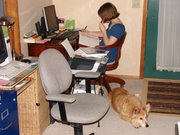Katie Meyers
Online Lab Two
Results
Here is an image of two dragons that have the exact same parent genes, resulting in these two dragons being identical.

Here is an image of how the dominant and recessive genes work in genetic inheritance by use of the Punnett square, as well as the results of different genotypes mixing.

Terms
Genotype – “The genetic makeup, as distinguished from the physical appearance, of an organism…” (http://dictionary.reference.com/browse/genotype). This is apparent in the dragon experiment, where the changes in genetic makeup either made the two dragons more similar or more different. The closer the two dragons’ genotypes were, the more similar they looked.
Phenotype – “The appearance of an organism resulting from the interaction of the genotype and the environment.” (http://dictionary.reference.com/browse/phenotype) This was also proven true by the dragon experiment. The closer the dragons’ genotypes were, the more their phenotypes looked alike.
Allele – A particular gene that codes particular genetic traits. As seen in the fly experiment, one of the fly parents had an allele that coded for one type of wings, while the other parent’s allele was coded for a different type of wings. As for which allele (hereditary trait) wins out, that depends on which genes are dominant and which are recessive.
Cross – This is when two parent organisms’ genes are combined, or essentially crossed, as seen in the Punnett square of the fly experiment (e.g. one parent has Ll, while the other has ll. Cross them according to the Punnett square to find out how likely/unlikely a certain phenotype will be found in their offspring.). This cross’s effect differs according to which genes are dominant and which are recessive.
Dominant – The alleles (genes) that are more likely to be found in two parents’ offspring. In the Punnett square, these are depicted by using capital letters. In both the fly experiment and the dragon experiment, the alleles that are portrayed with capital letters are known as dominant genes.
Recessive – The alleles (genes) that are less likely to be found in two parents’ offspring. If there is an even amount of dominant and recessive genes, it is likely the child will have the dominant gene’s looks. In the fly experiment, the only way to have a 50/50 chance for the two wing types in the offspring was to have six recessive genes and two dominant genes.
Conclusion
Both of these experiments were excellent examples of the concepts of meiosis and fertilization. Meiosis was shown in both experiments by the parent genes/cells having only one member of a chromosome pair in each. This concept was carried over into the idea of fertilization, where the combination of the parent meiosis genes resulted in which hereditary traits the offspring may have, and the likelihood of each possible trait.

No comments:
Post a Comment